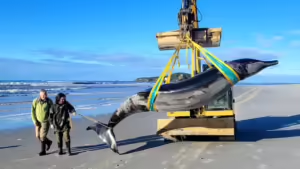Get ready, Antarcticans: Elon Musk is on his way with the magical gift of the internet.
SpaceX’s Starlink service came online at McMurdo Station, the giant U.S. base on Ross Island, on September 14.
The U.S. National Science Foundation, which funds the country’s Antarctic programs at McMurdo and elsewhere, tweeted the news.
“NSF-supported USAP scientists in Antarctica are over the moon! Starlink is testing polar service with a newly deployed user terminal at McMurdo Station, increasing bandwidth and connectivity for science support,” the agency said.
McMurdo operates as a key hub for geology and climate science programs taking place on the continent. Its existing satellite provider likely used Iridium satellites, which work in the polar regions but have painfully slow data transmission.
Since more people live at McMurdo than in some towns in the U.S., one would imagine that bandwidth is tight. It’s unclear how much difference the single Starlink terminal will make. The coverage area should not be a problem, but connection speed and reliability are question marks.
‘Space lasers’ seek to connect Antarctica
The terminals, which measure about 50cm x 30cm, provide internet in their immediate area. SpaceX satellites coordinate with certain “cells” on the planet’s surface. Cells are hexagonally-shaped and around 50 kilometres wide, by some accounts. Any active terminals within that cell will transmit internet service.
McMurdo fits inside that size area easily. But there’s no telling how many satellites are in orbit overhead, so the strength and stability of the connection are unknown. Starlink acknowledged the problem in its own tweet, stating that its “space laser network” was the only reason service was available at all “in such a remote location”.
Starlink is now on all seven continents! In such a remote location like Antarctica, this capability is enabled by Starlink’s space laser network https://t.co/c9HX0xrX0u
— SpaceX (@SpaceX) September 14, 2022
Space lasers are a literal shot in the dark, according to TechCrunch. The idea is to link internet broadcasting between distant satellites with a laser. It works, according to the outlet, as long as you can keep the beam on target. TechCrunch reported that Starlink has been testing the method “in a limited capacity”.
Deep freeze: ‘ruggedized’ terminals?
Finally, Starlink has not always designed its terminals to withstand Antarctic conditions. Winter temperatures at McMurdo plummet to -50˚C, and the company’s standard terminals can only handle -30˚. Some users elsewhere had already reported outages based on “thermal shutdown” at the terminals, according to Ars Technica.
The outlet did report that Starlink unveiled a “ruggedized” terminal design this January. However, the new rig’s specs and tolerances remained unclear, and availability was not a guarantee.
While high-speed internet in Antarctica doesn’t look like a reality quite yet, the McMurdo terminal still establishes a milestone: Starlink is now, at least theoretically, operating on all seven continents.
Final note: Skiers to the South Pole should not think that they can replace their Iridium units with high-speed Starlink. At four kilos, the satellite dish itself is not too bad, but it needs more power than a trudging human can sensibly provide. For now, Starlink is more of a boon for RVers and remote communities like McMurdo.






